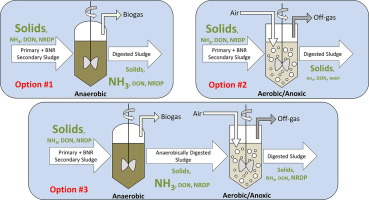Waste Management ( IF 7.1 ) Pub Date : 2020-03-23 , DOI: 10.1016/j.wasman.2020.03.019 Timothy Abbott , Cigdem Eskicioglu

|
Digestion of biological nutrient removal (BNR) plant sludge can be challenging, particularly for small- to medium-sized wastewater treatment facilities (WWTF) which often lack the economies of scale, and/or expertise to make digestion feasible. This study compared various types of sludge digestion, sludge retention times (SRTs), and temperatures on the release of recalcitrant nutrients, digestion economics, and digester performance utilizing mixed primary and secondary sludge from a small- to medium-sized BNR facility. Mesophilic anaerobic digestion (AD), cycling aerobic/anoxic (AERO/ANOX) digestion, and sequential anaerobic/aerobic/anoxic (AD/AERO/ANOX) digestion at room and mesophilic temperatures were compared at SRTs between 5 and 20 days. AERO/ANOX digestion was very effective in treating recalcitrant forms of nitrogen and phosphorous by removing up to 87% of dissolved organic nitrogen (DON), up to 88 ± 2% of non-reactive dissolved phosphorous (NRDP). AERO/ANOX digestion also offered the lowest increase in sludge management costs versus the existing no-digestion baseline scenario. ADs removed up to 53 ± 1% of volatile solids (VS), whereas unheated AERO/ANOX digesters were less effective, removing up to 39 ± 1% of VS. Sequential AD/AERO/ANOX digesters with a mesophilic second-stage removed up to 61 ± 3% of VS but had the highest operational and capital costs. Experiments also indicated that significant amounts of orthophosphate (PO43−) may be released from digested AERO/ANOX sludge during on-site storage, with longer SRTs releasing PO43− more rapidly than shorter ones. These results are important as more WWTFs deploy BNR to meet increasingly stringent nutrient limits.
中文翻译:

通过蒸煮器优化减少中小规模生物营养去除植物污泥中顽固性营养物和有机污染物
消化生物营养去除(BNR)植物污泥可能具有挑战性,特别是对于通常缺乏规模经济和/或使消化可行的专业知识的中小型废水处理设施(WWTF)。这项研究比较了各种污泥消化,污泥保留时间(SRT)和温度对顽固性养分释放的影响,消化的经济性以及利用中小型BNR设施中混合的初次和二次污泥的消化器性能。在室温和中温温度下,在5至20天之间比较了中温厌氧消化(AD),循环好氧/缺氧(AERO / ANOX)消化和顺序厌氧/好氧/缺氧(AD / AERO / ANOX)消化。通过去除高达87%的溶解有机氮(DON),高达88±2%的非反应性溶解磷(NRDP),AERO / ANOX消化在处理顽固形式的氮和磷方面非常有效。与现有的不消化基准方案相比,AERO / ANOX消化技术还可以将污泥管理成本的增加降到最低。AD去除了高达53±1%的挥发性固体(VS),而未加热的AERO / ANOX蒸煮器效果不佳,去除了高达39±1%的VS。带有中温第二阶段的顺序AD / AERO / ANOX消化池去除了VS的61±3%,但具有最高的运营和资本成本。实验还表明,大量的正磷酸盐(PO 与现有的不消化基准方案相比,AERO / ANOX消化技术还可以将污泥管理成本的增加降到最低。AD去除了高达53±1%的挥发性固体(VS),而未加热的AERO / ANOX蒸煮器效果较差,去除了高达39±1%的VS。带有中温第二阶段的顺序AD / AERO / ANOX消化池去除了VS的61±3%,但具有最高的运营和资本成本。实验还表明,大量的正磷酸盐(PO 与现有的不消化基准方案相比,AERO / ANOX消化技术还可以将污泥管理成本的增加降到最低。AD去除了高达53±1%的挥发性固体(VS),而未加热的AERO / ANOX蒸煮器效果较差,去除了高达39±1%的VS。带有中温第二阶段的顺序AD / AERO / ANOX消化池去除了VS的61±3%,但具有最高的运营和资本成本。实验还表明,大量的正磷酸盐(PO在现场存储过程中,可能会从消化的AERO / ANOX污泥中释放出4 3−),较长的SRT会比较短的SRT更快地释放PO 4 3-。随着越来越多的WWTF部署BNR以满足日益严格的营养限制,这些结果非常重要。











































 京公网安备 11010802027423号
京公网安备 11010802027423号